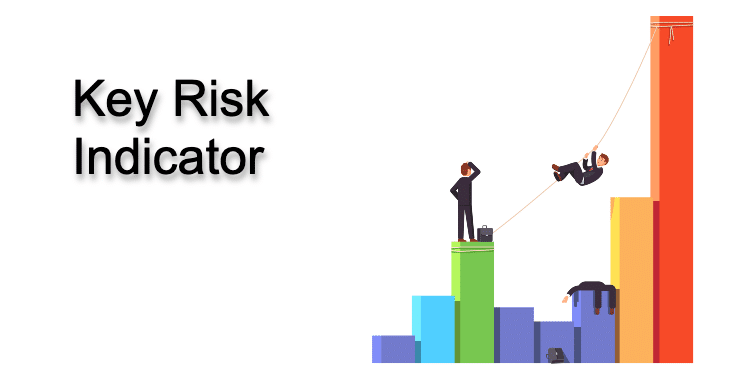What is a Key Risk Indicator?
According to Cobit 5, KRIs are metrics that provide insight into an enterprise’s level of risk. They highlight risks that exceed the organization’s established risk appetite.
Cyber Security Key Risk Indicators serve as early warning signals, offering a heads-up when there’s a spike in risk exposure in your cyber landscape.
How do KRIs differ from their more well-known counterparts, Key Performance Indicators (KPIs)?
Key Performance Indicators (KPIs) and Key Risk Indicators (KRIs) complement each other in cyber risk management. KPIs serve as measures of past performance, offering insights into how well various aspects of the organization have performed over a specific period. These operational risk metrics, such as revenue growth, customer satisfaction ratings, or production efficiency, act as benchmarks for evaluating the success or effectiveness of business strategies and initiatives.

Focus on Performance Achievement
- KPIs track progress towards achieving predefined goals and objectives.
- They serve as benchmarks for evaluating the success or effectiveness of business strategies, processes, and initiatives.
Examples of KPIs
- Cyber Risk Management Maturity
This KPI evaluates the maturity level of the organization’s cyber risk management practices and processes. It assesses factors such as the effectiveness of risk identification, assessment, mitigation, and monitoring activities, as well as the integration of cybersecurity into overall business processes. A higher maturity level indicates a more robust and proactive approach to cyber risk management.
- Cybersecurity Investment ROI
This KPI measures the return on investment (ROI) derived from cybersecurity investments and expenditures. It assesses the effectiveness of cybersecurity initiatives in reducing cyber risk, mitigating potential financial losses, and enhancing overall business resilience. Calculating cybersecurity investment ROI helps optimize resource allocation and justify budget allocations for security initiatives.
- Cyber Insurance Coverage Adequacy
This KPI measures the extent to which the organization’s cyber insurance coverage aligns with its cyber risk exposure and potential financial liabilities. It evaluates factors such as coverage limits, policy exclusions, deductible amounts, and claims processing efficiency. Ensuring adequate cyber insurance coverage helps transfer and mitigate financial risks associated with cyber incidents.
- Security Control Effectiveness
This KPI assesses the effectiveness of the organization’s security controls in mitigating cyber risks and preventing security incidents. It includes KPI metrics such as control failure rates, control coverage, and control deviation frequency. Monitoring security control effectiveness helps identify gaps or weaknesses in the organization’s security posture and prioritize investments in control enhancements or technology upgrades.
KRI’s
In contrast, KRI metrics provide a forward-looking perspective by focusing on identifying potential risks and vulnerabilities that could impact the organization’s objectives and performance in the future. These indicators serve as early warning signals for emerging risks, enabling organizations to mitigate them before they escalate into significant problems proactively. KRIs encompass various risks and help organizations anticipate and manage these risks effectively.
Focus on Proactive Risk Management
- KRIs enable organizations to anticipate and mitigate risks before they escalate into significant problems.
- By monitoring KRIs, organizations can take proactive measures to strengthen controls, adjust strategies, or allocate resources to mitigate potential risks.
Start Getting Value With
Centraleyes for Free
See for yourself how the Centraleyes platform exceeds anything an old GRC
system does and eliminates the need for manual processes and spreadsheets
to give you immediate value and run a full risk assessment in less than 30 days
Examples of KRI in Risk Management
Threat Intelligence Alerts
This KRI measures the frequency and severity of threat intelligence alerts received by the organization from external sources, such as security vendors, industry groups, or government agencies. Threat intelligence alerts provide early warning of emerging cyber threats, including malware outbreaks, phishing campaigns, and zero-day vulnerabilities. Monitoring this KRI enables proactive threat detection and response, enhancing the organization’s resilience to evolving cyber threats.
- Cyber Attack Surface Expansion
This KRI evaluates changes in the organization’s cyber attack surface, including the introduction of new technologies, applications, or network connections. An expanding attack surface increases the organization’s exposure to potential cyber attacks and vulnerabilities. Monitoring changes in the attack surface helps assess the impact on overall cyber risk posture and inform risk mitigation strategies, such as implementing additional security controls or conducting security assessments.
- Cyber Risk Score
This KPI quantifies the organization’s overall level of cyber risk exposure. It considers factors such as the organization’s asset inventory, vulnerabilities, threat landscape, and potential impact of cyber incidents. A cyber risk score provides a comprehensive view of the organization’s cyber risk profile and helps prioritize risk management efforts.
- Third-Party Risk Assessment
With increasing reliance on third-party vendors and service providers, organizations must assess and manage the security risks associated with these relationships. Conducting thorough assessments of third-party security practices and monitoring key risk indicators such as vendor compliance status, security incidents, and data breaches helps organizations mitigate the potential impact of third-party risks on their security posture.
- Financial Impact Analysis
Understanding the financial implications of cybersecurity incidents is essential for effective risk prioritization and resource allocation. By quantifying the potential financial impact of data breaches, system downtime, and regulatory fines, organizations can make informed decisions about cybersecurity investments and risk mitigation strategies. Monitoring financial risk indicators allows organizations to align their cybersecurity efforts with overall business objectives and risk tolerance levels.
KRIs enable management to make data-driven and informed decisions regarding risk management priorities and strategies.
- Aligning KRIs with the organization’s risk appetite and strategic objectives helps management teams prioritize resources and actions to address high-priority risks.
- Regular analysis and interpretation of KRIs provide valuable insights into the effectiveness of risk management initiatives.
Centraleyes: The #1 Cyber Risk Management Platform
Effective risk management requires choosing the security KRIs that fit your organization’s risk appetite. Every company has different stakeholders, goals, and risk tolerance. A comprehensive risk assessment is the first step in determining your unique risk exposure.
Once security KRIs are identified, thresholds and triggers must be defined. Each KRI has a threshold and triggers a signal when it has exceeded it, necessitating immediate action.
Regularly monitoring security-related KRIs has many benefits. They alert of potential security threats and provide retrospective insights into past security incidents, allowing for continuous development and learning. They provide real-time intelligence to decision-makers and risk managers about whether their risk appetite and tolerance thresholds are being exceeded.
Centraleyes’ Smart Risk Register feature maps your unique risks directly to security controls on a customized KRI dashboard. Incorporating a tool like Centraleyes can enhance an organization’s ability to manage and monitor its cybersecurity risks.
Start Getting Value With
Centraleyes for Free
See for yourself how the Centraleyes platform exceeds anything an old GRC
system does and eliminates the need for manual processes and spreadsheets
to give you immediate value and run a full risk assessment in less than 30 days





